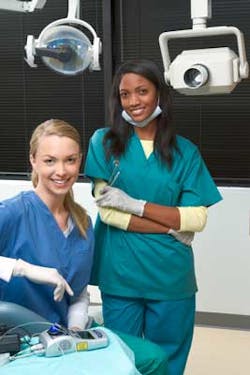I hope you agree that the dental hygiene appointment is a foundational component of optimal oral and systemic health. But, paradoxically, it is probably the most undervalued appointment in the dental office.
As a Pride consultant of over 12 years, I notice the hygiene appointment is still often referred to as “a cleaning” by both patients and team members, giving it the same status as a carpet or car cleaning. The term “cleaning” implies that hygienists are merely cleaning ladies (or men) and that since that references cosmetics, the attitude is that these appointments can be easily changed or even missed.
Therefore, an important step is to transform the “cleaning” mentality to one that more accurately describes the purpose of the appointment. You and your team must decide the most appropriate term for this important visit, whether it’s continuing care, hygiene, periodontal therapy, or periodontal maintenance/management. The purpose is to treat and maintain oral and overall health in patients. Identifying all treatment that occurs during the hygiene visit strengthens the philosophy that hygiene services are essential elements of patient ongoing treatment.
RELATED ARTICLES:Are you treating team members like children when you reward them?
Six steps to making the dental hygiene department a profit center
Building value through clinical care
Eliminating the word “cleaning” is one step toward building value for the hygiene services. The next is changing patients’ perceptions so that they recognize this is a real medical appointment. There is a considerable body of emerging research that demonstrates the link between gum disease and other health conditions. Unfortunately, many of your team members are unaware of these links, so it is important that everyone on the team can educate patients. If a patient’s medical history indicates a condition that is affected by gum disease, clinical team members should explain that the patient falls into a higher risk category and that care will be closely monitored.
The patient’s medical status should be noted in the patient’s records so that the front desk employees can refer to it if the patient tries to cancel or delay an appointment. The front desk employee could respond with, “You want to delay your appointment? I’m sorry to hear that. I see that you have diabetes and, as you know, this puts you in a higher risk category for gum disease, which may affect your health. I know that Holly would be very concerned if we delayed this appointment. Is there any way you could keep this appointment as scheduled?”
To ensure all team members have an understanding of the oral-systemic link, I invite you to add it to your next team learning meeting or share pertinent articles with your colleagues.
Periodontal maintenance
The periodontal maintenance visit is also often undervalued. Many patients perceive it as simply a more expensive “cleaning.” Therefore, everyone on the team needs to communicate how this appointment differs from a prophylaxis. “Mrs. Jones, because you have a chronic and non-curable bacterial infection called periodontitis, you will have therapeutic appointments with us from now on. The purpose of these appointments will be to disrupt bacteria that can colonize and release toxins into your bloodstream. During your periodontal maintenance visits, we will be using specialized tools and medicaments in order to arrest your gum disease.”
Action steps
- Eliminate the word “cleaning” when referring to the hygiene appointment.
- Educate team members and patients about the links between gum disease and their overall health.
- Record a patient’s health condition in a prominent place in the patient’s record and refer to it if the patient wants to change his or her hygiene appointment.
- Describe every action taken in the hygiene chair so that patients recognize they are getting more than “a cleaning.”
- Read aloud the patient’s periodontal scores and ask the patient to keep track of pocket depths that are greater than three to support codiagnosis.
- Give the patient a copy of his or her periodontal readings.
- Describe what the radiographs reveal about the patient’s oral condition.
- Identify how a periodontal maintenance visit differs from a “regular” hygiene appointment, and explain why the patient needs this treatment.
To learn strategies and systems to infuse immediate value into hygiene appointments and increase your hygiene department’s production, attend Pride Institute’s “Realizing the Hidden Gem of your Pratice: The Professional Hygiene Department" course Nov. 15 and 16 at Pride Institute Headquarters in Novato, Calif. Call 800-925-2600 for more information.






